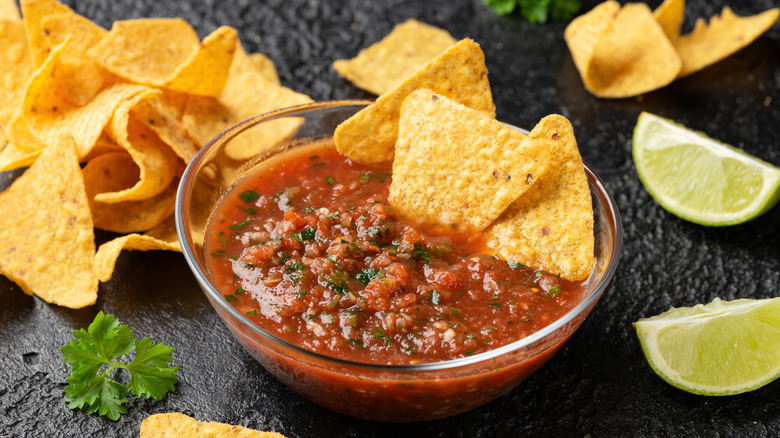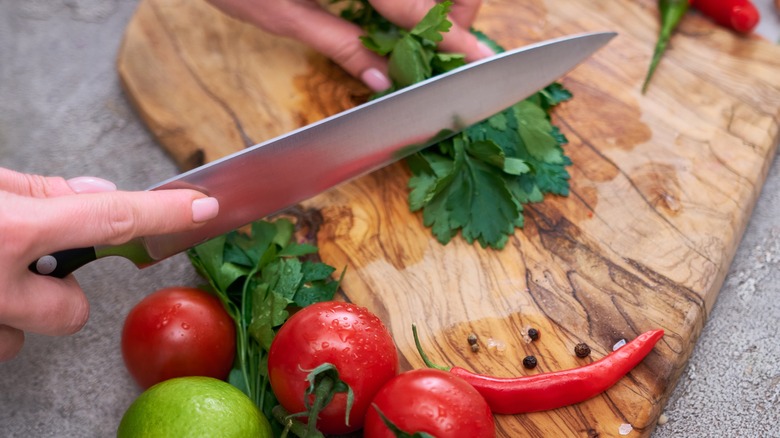What You Need To Know Before Freezing Salsa
Salsa is so much more than just a dip for corn chips. It is a truly versatile condiment that can spice up eggs, soup, and burgers, put some heat into a meatloaf, add a pop of flavor to stuffed peppers, and so much more. A big batch of homemade salsa can save you a ton of chopping and mixing time down the road when you want to make huevos rancheros or seven-layer dip, and you can tweak the flavor and spice precisely the way you want it — unlike store-bought versions. The problem is that if you make a lot of salsa you have to either eat it all within a few days or figure out how to preserve it. Canning is a great option, but there's a bit of a learning curve involved there. Thankfully, salsa freezes well if you follow a few simple guidelines.
Freezing salsa works best if you make cooked salsa, as opposed to pico de gallo which is uncooked. This is because fresh tomatoes have a lot of water in them, and when you thaw your salsa it will be watery and soggy which defeats the purpose of pico de gallo. Cooked salsa, on the other hand, works great in the freezer as long as you prep it properly or drain it after thawing.
Prep for freezing, or drain when thawing
Salsa is a great way to utilize a lot of tomatoes because it can be used in many different ways. In fact, you can substitute salsa in almost any recipe that calls for diced tomatoes and get an extra flavor kick. If you're planning to freeze extra salsa, however, remember that because of the water in tomatoes, when you freeze and thaw them, the ice crystals damage the fruit's cells, releasing the liquid. To combat this you can either chop or crush your tomatoes and drain away some of the liquid in a fine-mesh sieve or cheesecloth before you cook them, or you can make your salsa recipe normally, freeze it, and then drain it in the sieve or cheesecloth after it's thawed.
You can also use tomatoes that have less moisture in them, like "paste" tomatoes that are good for making tomato sauce, including Roma and San Marzano varieties. Some people also like to puree some of the salsa and add it back to thicken it, giving you a little more leeway when you thaw things out.
If you prefer to drain the extra liquid after thawing, be aware that you're also draining away some of the flavors. After you drain your salsa, taste it to see if you need to adjust the spices, and add a tablespoon or two of tomato paste to perk the flavor back up.
Perfect portions
Homemade salsa will last in the freezer for up to three months as long as you've stored it properly in sealed air-tight containers to prevent freezer burn. It's a good idea to freeze your salsa in usable portions so you can take out only what you need and keep the rest frozen. Try freezing it in quart-sized freezer bags if you tend to normally eat a whole jar of store-bought salsa when it's open. Just be sure to label and date any of your containers or bags so you don't lose track of how long they've been in the freezer. Also, be sure to thaw it thoroughly overnight in the refrigerator to prevent foodborne illness before serving.
If you like to use your salsa as a flavor component in recipes, you can freeze it in ice cube trays so that you can have a few tablespoons at a time as needed. Larger silicone trays — used for making fancy cubes for craft cocktails — are a great size for salsa because each cube holds around ¼ of a cup and it's easy to remember for measuring. The flexible silicone also makes it easy to pop them out of the tray.
Once you get your freezing routine down, you can confidently make a big pot of salsa once and have it in the freezer ready to gorge yourself on the spicy stuff anytime for months.


